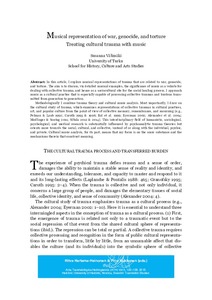Musical representation of war, genocide, and torture – Treating cultural trauma with music
Susanna Välimäki
https://urn.fi/URN:NBN:fi-fe2021042714136
Tiivistelmä
In this article, I explore musical representations of trauma that are related to war, genocide, and torture. The aim is to discuss, via detailed musical examples, the significance of music as a vehicle for dealing with collective trauma, and hence as a sociocultural site for the social healing process. I approach music as a cultural practice that is especially capable of processing collective traumas and burdens transmitted from generation to generation.
Methodologically I combine trauma theory and cultural music analysis. Most importantly, I draw on the cultural study of trauma, which examines representations of collective traumas in cultural practices, art, and popular culture from the point of view of collective memory, remembrance, and mourning (e.g., Felman & Laub 1992; Caruth 1995 & 1996; Bal et al. 1999; Eyerman 2002; Alexander et al. 2004; Modlinger & Sontag 2011; Siltala 2012 & 2014). This interdisciplinary field of humanistic, sociological, psychological, and medical research is substantially influenced by psychoanalytic trauma theories but orients more towards the social, cultural, and collective, instead of or along with the individual, psychic, and private. Cultural music analysis, for its part, means that my focus is on the sonic substance and the mechanisms therein that construct meaning.
Kokoelmat
- Rinnakkaistallenteet [19207]
